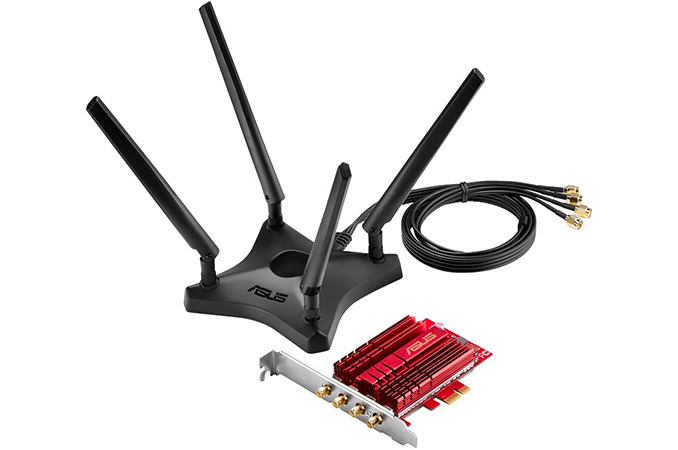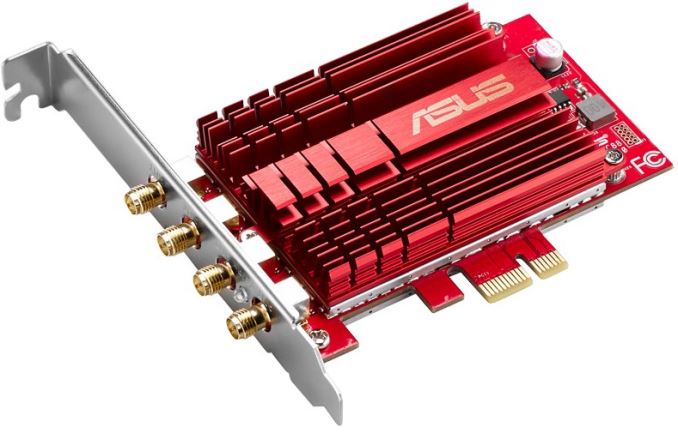ASUS Unveils PCE-AC88 4x4 Wi-Fi Card with 2167 Mbps Bandwidth
by Anton Shilov on May 11, 2016 11:00 AM EST- Posted in
- Networking
- Asus
- Broadcom
- 802.11ac
- PCIe x1

ASUS has introduced its flagship dual-band AC3100 wireless PCIe x1 adapter with four antennas and a maximum supported throughput of 2167 Mbps (270 MB/s). The card is powered by Broadcom’s flagship 802.11ac Wave 2 system-on-chip for Wi-Fi adapters and to show its best, it has to be connected to a router featuring another high-end Broadcom SoC.
The ASUS dual-band AC3100 wireless (PCE-AC88) PCIe adapter is based on the Broadcom BCM4366 SoC introduced early last year. The BCM4366 supports 4x4 802.11ac MU-MIMO technology and can thus use four 802.11n (2.4 GHz/5 GHz) or four 802.11ac (5 GHz) streams. The PCE-AC88 is a small half-height card that features PCIe x1 interface (the Broadcom chip supports PCIe 3.0, but exact data rate of the card is not given) and is equipped with a large big red cooler, and it is particularly large compared to other WiFi heatsinks. The device features four RP-SMA connectors for antennas as well as a special external magnetic base for the antennas which may be installed on top of a desktop PC or positioned somewhere else for better radio performance.
To actually hit the maximum bandwidth, the card has to be connected to routers powered by Broadcom’s latest Wi-Fi SoCs that support TurboQAM (256 quadrature amplitude modulation) and NitroQAM (1024 quadrature amplitude modulation) technologies. For pairing, ASUS currently offers its AC3100 (RT-AC88U) and AC5300 (RT-AC5300) routers, which support both TurboQAM and NitroQAM features. Netgear offers its Nighthawk X8 R8500 AC5300 router, which also supports maximum bandwidth up to 2167 Mbps.
The ASUS PCE-AC88 card was approved by the FCC in late November 2015, and is currently listed on ASUS’ website. The product is ready and may emerge for sale anytime, but its price is still unknown. Keeping in mind that the ASUS PCE-AC68 costs around $95, we expect the newest and fastest one to be at a higher price.
At present, the ASUS dual-band AC3100 wireless (PCE-AC88) PCIe adapter seems to be the only add-in Wi-Fi card for desktops which supports speeds up to 2167 Mbps using a 4x4 SoC. The part should come in handy for various media center PCs or NAS environments where wired Ethernet is absent but can benefit from high network speeds.
Source: ASUS (via TechPowerUp).
















26 Comments
View All Comments
Agent Smith - Thursday, May 12, 2016 - link
I too got fedup with Win10 bluescreen when torrenting so initially just used a virtual desktop but later switched to an enterprise version of Win7. The later option gave me no Win10 upgrade bags and full compatibilty with all my older software i'd bought.I think i'll wait another year before switching back to Win10 as theyre clearly too interested in pushing out features rather than fixing thousands of irritating bugs.
Agent Smith - Thursday, May 12, 2016 - link
Nags (not bags)Edit option please Nand?
CaedenV - Wednesday, May 11, 2016 - link
The more I see of these fancy new cards, the more I keep thinking that there needs to be a nicer way to add this to my server and use it as an AP. Then, as newer and better cards come out ever 6-8 months I can get a much cheaper upgrade than replacing my entire SoHo router.easp - Wednesday, May 11, 2016 - link
I wouldn't assume that these things work well in access point mode.Daniel Egger - Wednesday, May 11, 2016 - link
Meh, no Bluetooth...Freakie - Wednesday, May 11, 2016 - link
No... Bluetooth...? Is a USB dongle really that bad? Bluetooth doesn't exactly need the PCIE interface.JoeyJoJo123 - Wednesday, May 11, 2016 - link
Well, laptops usually have wifi + bluetooth built into the same small add-in card.For a PCI-E WiFi card that will likely retail for over $150, it's not unreasonable to be disappointed that bluetooth wasn't an extra thrown in there as well.
MrSpadge - Wednesday, May 11, 2016 - link
I think this post should have triggered your sarcasm detector.name99 - Wednesday, May 11, 2016 - link
1024QAM???What are the circumstances under which this EVER has the slightest chance of working? You'd figure even the background radio noise in the middle of nowhere would be too high to allow it to differentiate between levels. Is it designed for use in either deep space or at the South Pole?
DanNeely - Wednesday, May 11, 2016 - link
It worked great when the card and router were 3 inches apart inside the anechoic chamber in Asus's RF lab. /facepalm